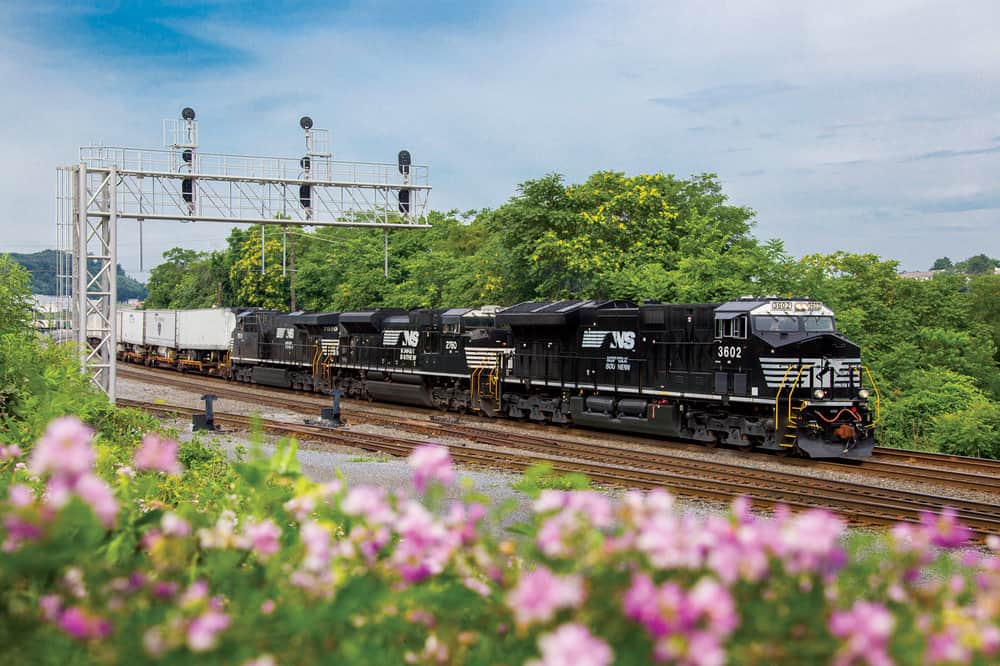
Even at an investors’ conference sponsored by Cowen Inc. in Boston, Norfolk Southern couldn’t get away from CSX.
Appearing before investors about 3 1/2 hours after CSX CFO Frank Lonegro on Tuesday kicked off one stream of presentations at the Cowen meeting, her counterpart at Norfolk Southern, Cindy Earhart, faced questions about why its operating ratio in the second quarter was significantly worse than that of northeast competitor CSX. For the quarter, NS posted an OR of 64.6%, a record for the second quarter in which is also posted several other record-breaking figures.
But CSX’ was 58.6%, and back when the numbers were announced, and in the Norfolk Southern earnings call, there was implicit criticism on the part of several analysts as to why NS didn’t do as well as CSX. The two railroads have significant overlap in their systems in the eastern part of the country.
Jason Seidl, the host of the conference and Cowen’s lead transportation analyst, said in a fireside chat with Earhart that he believed it was an “unfair comparison, given your record results.” Still, he asked Earhart to compare the two companies and possible find explanations for the difference in ORs. “Are there major differences that could prevent Norfolk Southern from getting to CSX’ levels now, or are these just two railroads taking different paths to get to the same place?” Seidl asked.
Earhart said NS continues to have a “lot of confidence” in delivering on its financial targets. But she indicated that the concerns raised by analysts have been heard, and the company’s third quarter earnings call would likely have focus on what NS will do to improve its productivity; she did not mention CSX by name. “You’ll hear more when we talk about our plans,” she said.
“We’re looking at every area of the company,” Earhart said. “We are highly focused, and we understand margin improvements need to be a big part of that. We recognize that there are going to continue to be opportunities for us to push productivity.”
An unidentified questioner on the webcast of the presentation–FreightWaves listened to the discussion via webcast–was more pointed in his questioning. He noted that NS consistently had superior ORs to CSX, and he referred to thinly-veiled suggestions made by NS management on occasion that an excessive focus on OR could damage growth opportunities. “Why is it that more growth means it has to be a little worse OR?” he said. “I don’t get that.”
Earhart again reiterated that an effort to improve productivity will be a focus of NS going forward. But she also said we “want to be able to grow with our customers,” and suggested that some slack in a system can enable rail companies to grab those opportunities.
Earhart focused on improvements in various metrics, with dwell time and average network speed as key benchmarks. But taking a snap shot of the weekly data provide by the Surface Transportation Board does not indicate things are improving substantially. For example, a year ago, average system dwell time was 24.5 hours, according to STB, while in its most recent report, STB said system dwell time was 26.1 hours. The average speed in the system was down to 19.6 from 21.5. Dwell time is down from the end of March but system speed is not.
Lonegro, in representing CSX, talked about a company that continues to implement precision railroading. It’s a difficult concept to summarize easily, but it generally involves moving away from a hub and spoke system, moving more toward poit-to-point shipments, and in the process paring back service.
He said those changes have resulted in some metrics that would appear to be reducing capacity, such as additional storing of locomotives. But he said of the upcoming peak season, “We’re ready to handle those volumes in a precision railroad way.”
Part of that focus will be CSX’ intermodal division. According to Lonegro, the intermodal sector at CSX accounts for about 40% of its volumes but only 20% of its revenue.
“How do improve profitability and reliability?” he said. “We want it to be more truck-like.” As part of that, CSX is engaged in some changes in its intermodal division, which include more direct routing and less hub and spoke; increasing train lengths; and trying to stay away from Chicago and do interchanges elsewhere.
He said those changes have resulted in some metrics that would appear to be reducing capacity, such as additional storing of locomotives. But he said of the upcoming peak season, “We’re ready to handle those volumes in a precision railroad way.”
“We’re looking for the opportunity to take out miles,” Lonegro said. “Execution is the key.” It also may involve closing some intermodal terminals. Lonegro said CSX is having “candid conversations with our customers,” letting them know that eventually, “if we can’t serve a destination or origin effectively, then we probably shouldn’t serve that terminal at all.”
He added that no changes in terminal operations were going to be implemented during the upcoming peak shipping season.
In the same way that NS gets questioned about its OR, CSX has faced questions about whether its focus on rationalization of assets might limit opportunities in growing markets. Lonegro cited the recent re-opening of the Nashville hump yard as an example of CSX’ willingness to add service where it is necessary. “If it turns out there is significant growth in a particular area, we would look at another hump,” he said.
But Lonegro also said that CSX has probably taken out about 20% of its network through precision railroading, but still spent a billion dollars in other investment. As a result, as far as capacity, “we’re in a good spot,” he said.







